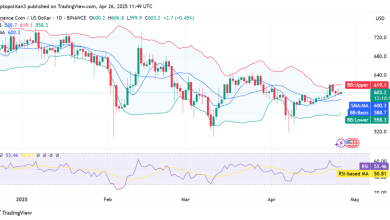USD/CHF rallies to one-month top, beyond mid-0.8400s as US and China agree to lower tariffs

- USD/CHF catches aggressive bids at the start of a new week amid the US-China trade deal optimism.
- Easing US recession fears and the Fed’s hawkish pause boost the USD and also support spot prices.
- The upbeat market mood undermines the safe-haven CHF and provides an additional lift to the pair.
The USD/CHF pair builds on its modest gap-up opening at the start of a new week and gains strong positive traction during the early part of the European session. The momentum is sponsored by the latest optimism over the US-China trade deal and lifts spot prices beyond mid-0.8400s, or over a one-month high in the last hour.
The US Dollar (USD) strengthens across the board following the positive outcome from the first round of high-level US-China trade talks held over the weekend in Geneva, Switzerland. In a rare joint statement, the US and China announced that both delegations agreed to substantially lower tariffs for an initial period of 90 days, marking the end of the tit-for-tat tariffs war between the world’s two largest economies. This, in turn, helps to ease market concerns about a US recession, which, in turn, provides a strong boost to the US Dollar (USD) and the USD/CHF pair.
Meanwhile, the Federal Reserve’s (Fed) hawkish signal last week, that it is not leaning towards cutting interest rates anytime soon, continues to push the US Treasury bond yields higher. In fact, the yield on the benchmark 10-year US government bond spikes to its highest level since April 10 and turns out to be another factor benefiting the buck. Apart from this, the risk-on impulse – as depicted by a strong rally across the global equity markets – is seen undermining the safe-haven Swiss Franc (CHF) and further contributing to the USD/CHF pair’s strong intraday positive move.
Moving ahead, there isn’t any relevant market-moving economic data due for release from the US on Monday. However, trade-related optimism should continue to act as a tailwind for the USD and support prospects for a further appreciating move for the USD/CHF pair. Traders now look forward to this week’s release of US inflation figures – the Consumer Price Index (CPI and the Producer Price Index (PPI) on Wednesday and Thursday, respectively. Apart from this, Fed Chair Jerome Powell’s appearance on Thursday might provide cues about the future rate cut and drive the USD.
Swiss Franc FAQs
The Swiss Franc (CHF) is Switzerland’s official currency. It is among the top ten most traded currencies globally, reaching volumes that well exceed the size of the Swiss economy. Its value is determined by the broad market sentiment, the country’s economic health or action taken by the Swiss National Bank (SNB), among other factors. Between 2011 and 2015, the Swiss Franc was pegged to the Euro (EUR). The peg was abruptly removed, resulting in a more than 20% increase in the Franc’s value, causing a turmoil in markets. Even though the peg isn’t in force anymore, CHF fortunes tend to be highly correlated with the Euro ones due to the high dependency of the Swiss economy on the neighboring Eurozone.
The Swiss Franc (CHF) is considered a safe-haven asset, or a currency that investors tend to buy in times of market stress. This is due to the perceived status of Switzerland in the world: a stable economy, a strong export sector, big central bank reserves or a longstanding political stance towards neutrality in global conflicts make the country’s currency a good choice for investors fleeing from risks. Turbulent times are likely to strengthen CHF value against other currencies that are seen as more risky to invest in.
The Swiss National Bank (SNB) meets four times a year – once every quarter, less than other major central banks – to decide on monetary policy. The bank aims for an annual inflation rate of less than 2%. When inflation is above target or forecasted to be above target in the foreseeable future, the bank will attempt to tame price growth by raising its policy rate. Higher interest rates are generally positive for the Swiss Franc (CHF) as they lead to higher yields, making the country a more attractive place for investors. On the contrary, lower interest rates tend to weaken CHF.
Macroeconomic data releases in Switzerland are key to assessing the state of the economy and can impact the Swiss Franc’s (CHF) valuation. The Swiss economy is broadly stable, but any sudden change in economic growth, inflation, current account or the central bank’s currency reserves have the potential to trigger moves in CHF. Generally, high economic growth, low unemployment and high confidence are good for CHF. Conversely, if economic data points to weakening momentum, CHF is likely to depreciate.
As a small and open economy, Switzerland is heavily dependent on the health of the neighboring Eurozone economies. The broader European Union is Switzerland’s main economic partner and a key political ally, so macroeconomic and monetary policy stability in the Eurozone is essential for Switzerland and, thus, for the Swiss Franc (CHF). With such dependency, some models suggest that the correlation between the fortunes of the Euro (EUR) and the CHF is more than 90%, or close to perfect.




